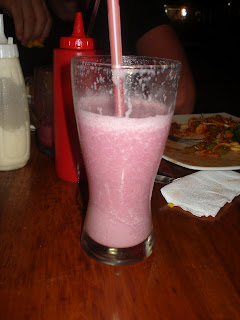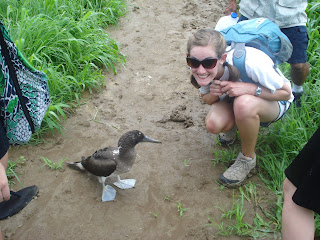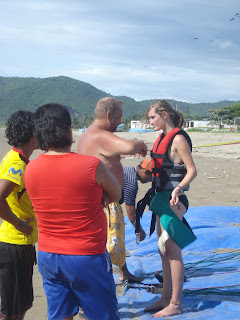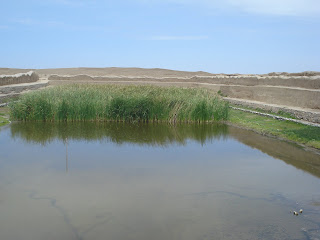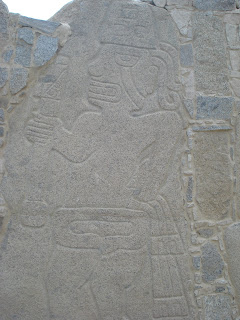After leaving Barranca and Caral, we headed to back to the cordillera (mountains) of Peru. In my opinion, the cordillera of Peru is a lot more beautiful than the coast. The whole coastline is desert, and I'm not really a desert person. The cordillera, however, the area surrounding it is green, with snow capped mountains...beautiful every direction you look.
We took a colectivo (shared taxi) over the mountains because it was safer and faster than buses. It was fun to watch the scenery change as we got closer to the cordillera, from a desert landscape to green hills to a backdrop of the Andes. The town itself was fine--the third biggest city in Peru and a major launching point for outdoor excursions (although since it's rainy season, there are a lot less people than during the dry season). The one good thing about it being a tourist hub? Lots of good food to choose from. I like Peruvian cuisine a lot, but it was nice to take a break and have some things like curry and salad. (Okay note: I had expected the vegetable situation to be the same in Peru as it had been in Central America--boil or peel. However, it turns out you can actually drink the water in Lima, and the water and vegetables are not as "dangerous" here as in central America. Another words, you still need to use you best judgement in where to eat, but in general you can actually eat a salad and other veggies and not worry about getting some really bad parasite because of doing so.)
Anyways, on our first day we just wandered around the town and took in the sights and enjoyed the food. The next morning we got up to go to Chavin de Huantar--a famous religious sight (sort of) near Huaraz. It actually ended up being about a 3 hour drive each way, but we got to go inside of the pyramid at the site which was AWESOME. The actual ruins themselves were a lot less impressive than some we had seen previously, but the fact that we got to go inside of the pyramid was just really cool.
The day after that we got up really early (5:30....) to got on a hike up in the mountains. We were originally planning on taking colectivos, because it was a lot cheaper than going with a tourist agency. But as we were waiting for the colectivos, a tourist van pulled up that had some extra spots and offered to take us for only s./10 more than it would have been in a colectivo, so we decided to go. The hike was one of the most beautiful and most challenging hikes I have ever been on. We started at a little below 12,000 feet (3,900 meters) and climbed up to about 14,500 feet (4,700 meters)--so the altitude definitely added to the difficultly of the hike.
I had trouble picking pictures, so there are a lot from the couple of days :)

Delicious, fresh mango juice at one of the cafe's in Huaraz. Also, (this is for you Mom, because I tried to show you over skype and it didn't work) a really nice, warm alpaca shawl :)

Maya and I at one of the lakes on the way to Chavin. The drive on the way there didn't seem to take too long. We got to stop and see this lake, which was pretty, as well as some other fun things along the way. The drive back, however, seemed to take forever. This road was probably the worst we went on in Peru. I don't think it's used very often, so they don't maintain it a whole lot...there are potholes everywhere, meaning they can't drive more than like 10 mph (or so it seemed) for fear of running into one. The upside of the drive home: a beautiful sunset in the altiplano (this lake is at 4,000+ meters, about 12,000+ feet)

This is the front of the pyramid at Chavin de Huantar. It was a religious site for Chavin culture. If I remember correctly from the sign in front, it was built between 100-800 BC (I could be a little off on my dates). In any case, the priests would go inside the pyramid (where only people of a certain standing were allowed in) and smoke San Pedro Cactus to be closer to the gods and have visions. Later, they would carve what they had seen during their "visions" into stone tablets. Hence, there are lots of really cool, slightly creepy carvings from Chavin.

In front of the main entry way to the outside of the pyramid. The interior pillars are intricately carved: one side is a woman, which at one point was white and is supposed to represent the good; the other side is a man, and was black, and is supposed to represent the bad. (All the old culture's in Peru were all about duality and having equality and two of everything to balance out).

Chavin has a really complex system of underground canals that brought water to the site. Our guide was also saying something about the priests walking in the canals, which confused me, because if they are full of water...how can the priests walk in them? Anyways, they run throughout the entire site.

Inside the pyramid. This was by far my favorite part. It was a whole intricate labyrinth of hallways and dead ends throughout the entire pyramid. There were windows looking between the rooms, and, every once in a while, you could see a "ventilation" window with a little sliver of natural light peeking through.

Being a bad tourist and taking pictures of locals...but her hat and cape are just so cool. All the locals would tie clothes around their shoulders to protect them from the rain. Plus, the river and background are really pretty too.

An intricately carved conch shell that they found at Chavin.

One of the many interestingly carved stone tablets found at the site. I wonder WHAT exactly it was they were seeing. If those were the kind of visions I had, I think I would be pretty scared.

Back in the day, the pyramid at Chavin was covered in these heads. The Chavin culture (along with a lot of other pre-Colombian cultures) thought the feline was sacred animal. Thus, many of their divine creatures, and depictions of priests, have feline-like characteristics.

The sunset over the altiplano on the way home.

The next morning, bright and early, on our drive up the mountain. We first had to drive about 2.5 hours to even arrive at the trail head. This was one of the lakes we passed along the way. There was a group of three of them name: Mom lake, Dad lake, and baby lake (or something to that effect). The water was so turquoise and beautifully blue. The fog that was surrounding the lake just made it look that much more mysterious.

Some Andean geese in swimming in the lake. And, though it's kind of hard to see in this picture, the black bird swimming along side them has a bright blue beak! About the same color as the water...

One of many waterfalls we saw along our hike. The two main ones were named "big waterfall" and "small waterfall". We knew we were on the right track when we passed in between them. (We had a very professionally drawn hand map...saracastic, in case you can't tell, we got lost several times on the trek). We basically hiked from the bottom of this waterfall up to the top.

My extremely puffed up yogurt from going up in altitude. I could definitely feel the altitude as we went up as well. I felt like my head was expanding just like my yogurt lid... A couple of the girls actually ended up having to turn around because they got so sick from the altitude. Maya and I could both feel it quite a bit, but we both really wanted to make it up the mountain, so we pushed through. Later on that night, however, our bodies protested for putting them through so much stress.

The whole group at our destination, Lake 69. How it received that name? I have no idea, but I would like to find out. It was one of the most beautiful lakes I had ever been to. As you can see from the photo, it is a perfect blue color. There were two waterfalls on either side cascading down into the lake. Up on top was a glacier (glacier, not iceburg Mom ;), hence I think the lake is made from glacier melt, giving it that perfect blue color (that's just my guess, I'm not positive)

You can see the beautiful contrast between the green plant and the blue water. Of course, it started to rain on us on our way down the mountain...

The path turned into a waterfall. Although it is a bit hard to tell in this picture, we were basically wading through water. Although the hike was extremely rewarding, and the views were spectacular, I think everyone was happy to make it back to the car and ride the rest of the way back to Huaraz.

Coming up next: more ruins in Casma/Sechin, Chan Chan and Huacas del Sol y la Luna. The beach at Huancahco and finally...Ecuador!! This is picture of one of the rock slides on the road from Huaraz to Casma. Luckily, there were no rock slides while we were driving and we had a good driver who drove very carefully around them.
*correction from my last blog. Caral was city 5000 years before present, aka 3000 BC. Likewise for Mesopetamia and Egypt, I got my dates a little mixed up. Also, I would like to point out that following the diagram I read at Sechin, modern humans evolved 40,000 years ago. That means it took them 35,000 years to actually build anything that lasted until present day...that's a really long time!
Anyways, Huaraz was beautiful. We had wanted to go on another hike the day after Lake 69 but were both so dead tired after the previous day's hike that we just decided to head to Casma. I have to say...while I love the mountains, it's nice to be at sea level again.


